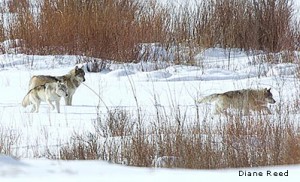We have much more to do and your continued support is needed now more than ever.
Sharks and Wolves: Separated at Birth?

In both cases, the predators not only help control prey populations but also alter prey behavior through the “ecology of fear,” the term biologists are applying to the way predation affects how prey species use habitat.
Ecological Similarities
In a study published in Frontiers in Ecology and the Environment, scientists from Oregon State University (OSU) and the University of Washington tread new ground. And water. “For too long we’ve looked at ecosystem functions on land and in the oceans as if they were completely separate,” says William Ripple, a professor in the OSU Department of Forest Ecosystems and an international expert on large predators. “We’re now finding that there are many more similarities between marine and terrestrial ecosystems than we’ve realized. We need to better understand these commonalities and, from them, learn how interactions on land may be a predictor of what we will see in the oceans, and vice versa.”

You can symbolically adopt a shark or a wolf from our adoption center today! You’ll help NWF continue our work to save wildlife.
Similar effects take place between the Australian sharks and dugongs, the researchers found. When the sharks are abundant, dugongs graze less in shallow water, where seagrass grows thickest but dugongs are most vulnerable to sharks. This shift in feeding habitat—which causes the dugongs to give up food they might otherwise consume—allows seagrass meadows to thrive, along with a range of other plants and animals that depend on the vegetation.

Apex Consumers
Tiger sharks and gray wolves are apex predators—animals that, at maturity, prey on other species but are rarely preyed on themselves. The ecological importance of apex consumers is becoming increasingly clear as the body of research on these animals grows, showing that loss of or declines in these species can ripple throughout ecosystems. For more information, see the current issue of National Wildlife magazine.
The photographs in this blog were donated to NWF by entrants in the annual National Wildlife Photo Contest. Do you have photos you would like to put into competition? Here’s how you can do it.





















